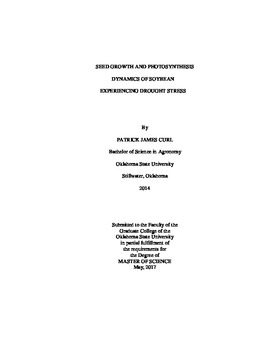| dc.description.abstract | Soybean [Glycine max (L.) Merr.] yield is sensitive to drought stress during critical reproductive growth stages. This study was conducted to determine both the ability of the soybean to recover after drought stress has subsided and to determine if a specific soil moisture matric potential could be identified as a reference for plant stress, and thus serve as a practical irrigation guide. Soybeans were subjected to drought stress during pod-fill (R5) in a growth chamber study and measurements of the growth of individual beans were collected non-destructively. In a complementary field study with rain-fed and irrigated soybean plots, measurements of photosynthetic CO2 assimilation, stomatal conductance, leaf fluorescence, and leaf relative water content were recorded near Braman, OK, on an Ashport silt loam (fine-silty, mixed, superactive, thermic Fluventic Haplustolls). In the growth chamber study, a four-day drought with soil matric potential not dropping below -200 kPa, was sufficient to abort 10.5% of initiated beans, reduce the final mass of individual beans by 20%, and depress the growth rate of beans by 25% after the drought stress had been removed for 5 days. The transition point from positive growth to negative growth occurred when soil matric potentials dropped below -60 kPa. Plant metrics from the field trial confirm that drought stress conditions occurring when soil matric potentials fall below -60 kPa can negatively influence the growth and development of soybean. This susceptibility of soybean to relatively mild drought stress, supports the need for improved soil moisture monitoring when irrigation capabilities are present. Direct monitoring of the soil matric potential would improve the accuracy of estimating the plant water status indirectly via the water status of the soil, and irrigation scheduling utilizing a -60 kPa base level would help to avoid yield losses due to drought stress. | |
